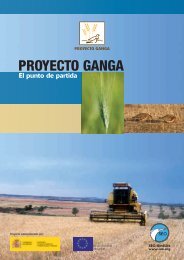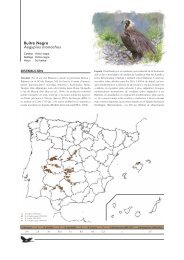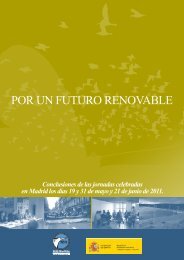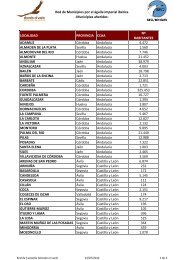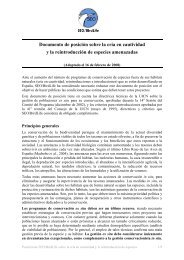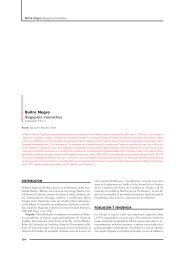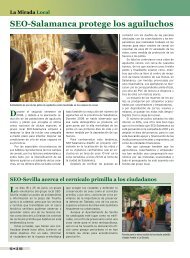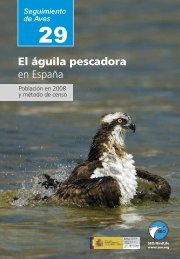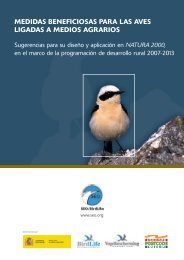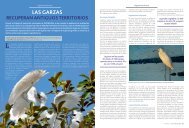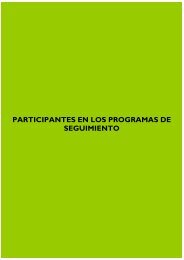El milano real en España. II Censo Nacional (2004) - SEO/BirdLife
El milano real en España. II Censo Nacional (2004) - SEO/BirdLife
El milano real en España. II Censo Nacional (2004) - SEO/BirdLife
You also want an ePaper? Increase the reach of your titles
YUMPU automatically turns print PDFs into web optimized ePapers that Google loves.
Red kite in Spain<br />
Madrid, however, has se<strong>en</strong> an increase in the wintering population.This population<br />
is conc<strong>en</strong>trated both on the eastern side of the region, and the mid-Jarama<br />
River valley, with the southern wintering nuclei having disappeared. The scarce<br />
numbers in western locations are thought to be part of the resid<strong>en</strong>t population.<br />
The second most important wintering area within Spain is Extremadura, which<br />
nonetheless records a wintering population 23.2% smaller than that of 1994.<br />
However, the decrease is unev<strong>en</strong> betwe<strong>en</strong> provinces. The decrease in Cáceres<br />
has be<strong>en</strong> 9%, with lower wintering numbers in the north and stable numbers in<br />
the southern <strong>en</strong>d of the province. On the contrary, a dramatic decline of some<br />
58% has be<strong>en</strong> recorded for the main wintering areas in Badajoz.<br />
The declining records for Castilla-La Mancha are betwe<strong>en</strong> 33.6% and 55.7%.<br />
Ciudad Real and Toledo are the provinces with the largest wintering numbers. In<br />
Ciudad Real, numbers have gone from 500-700 red kite individuals in 1994 to<br />
188-198 in <strong>2004</strong>; in Toledo, the 400 individuals recorded in 1994 have dropped to<br />
only 74 in the <strong>2004</strong> c<strong>en</strong>sus. Cu<strong>en</strong>ca province remains stable with 240-300 wintering<br />
individuals, whilst two roosting sites have be<strong>en</strong> id<strong>en</strong>tified in Albacete and<br />
Guadalajara with 42 and 116 individuals, respectively. These two locations were<br />
considered occasional wintering areas in the 1994 c<strong>en</strong>sus, and the increase<br />
recorded is possibly due to an improved survey rather than to an actual population<br />
increase.<br />
As to the situation in Andalucía, the data available does not allow for total estimates.<br />
In the Balearics, in turn, a small wintering stage with 23 individuals in<br />
<strong>2004</strong> exists on the island of Mallorca, whilst the population in M<strong>en</strong>orca does not<br />
vary during the winter months.<br />
Breeding population c<strong>en</strong>sus<br />
The Spanish breeding population was considered to be the second most important<br />
one in the world, with only Germany having higher figures (Tucker &<br />
Heath, 1994). The decrease in the population, according to the latest breeding<br />
c<strong>en</strong>suses, reflects a critical situation for the species. The 1994 estimates were<br />
3.333–4.054 pairs for the whole Spanish territory, whilst in the 2001 and <strong>2004</strong><br />
c<strong>en</strong>suses only 1.994-2.167 pairs were recorded (table 4). The latter estimate does<br />
not include the populations in Extremadura, the second region in importance after<br />
Castilla y León, or Andalucía. Wh<strong>en</strong> considering only the regions for which<br />
data exist both in the 1994 and the <strong>2004</strong> c<strong>en</strong>suses, the decrease in the breeding<br />
population is 46%. The decrease has affected all regions except for Navarra,<br />
126



